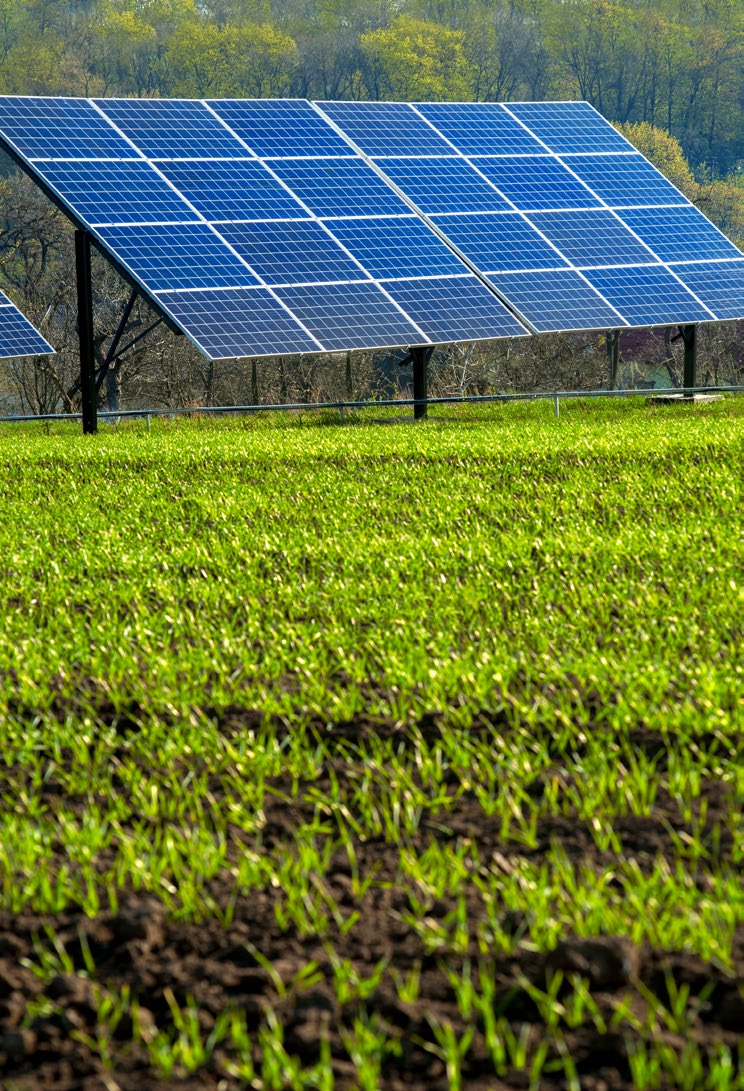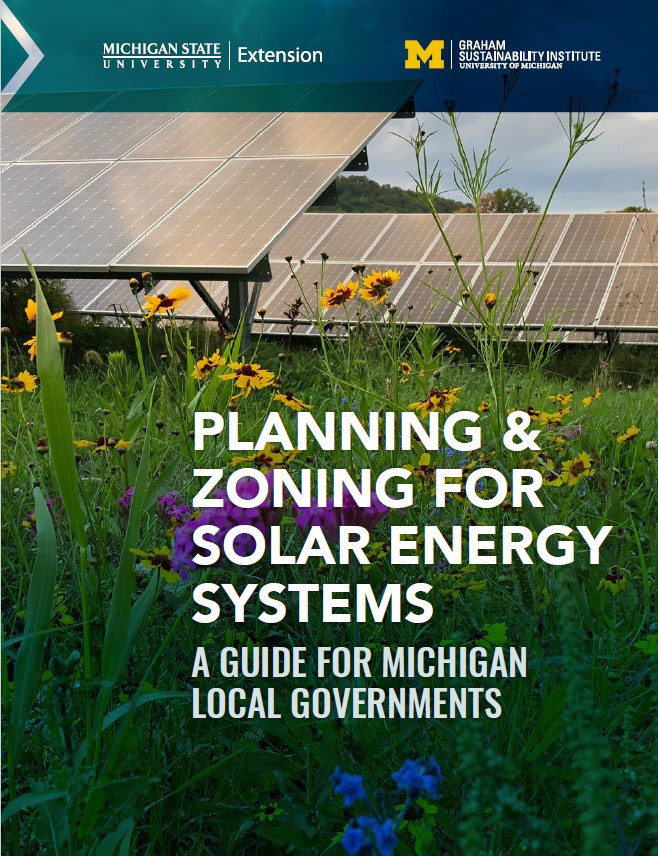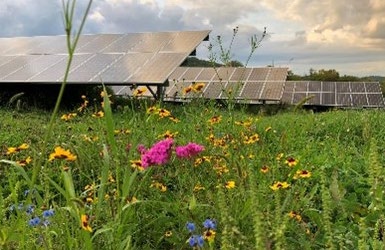
MSU Extension Provides Viable Options for Ag and Solar Integration
DOWNLOADMay 12, 2022 - MSU Extension
Impacts
Michigan aims to achieve economy-wide carbon neutrality by 2050 and maintain net negative greenhouse gas emissions thereafter. To ensure progress toward this goal, the state aims to achieve a 28% reduction below 1999 levels in greenhouse gas emissions by 2025.³ Solar power production will play a prominent role in meeting the state’s greenhouse gas emission reduction goal. Michigan State University Extension provides resources and information to utilities, local governments and the agricultural industry to help make decisions that allow agricultural land management and conservation practices to be integrated into solar projects. Doing so will ensure a continued strong agricultural presence in rural Michigan and ongoing development of solar projects.
- 8,000 MW By 2040, Consumers Energy Intends to build roughly 8,000 MW of solar energy.¹
- 11 Million More than 11 million solar panels will generate clean energy through DTE. 4
- More than 60% of Consumers Energy electric capacity will come from renewable sources by 2040.¹
- 8,000 Megawatts Consumers Energy plans to add nearly 8,000 megawatts of solar power by 2040.¹
- Net Zero DTE has set a bold goal to achieve net zero carbon emissions by 2050.²
- 80% DTE intends to reduce carbon emissions by 80% by 2040.²
- 500,000 Homes Since 2009, DTE has invested $2.8 billion in wind farms and solar arrays, providing enough clean energy to power 500,000 homes.²
- MSU Extension helps preserve farmland and pollinator habitats by recommending that agricultural land management and conservation practices are included in local zoning ordinances.
- MSU Extension supports environmentally sustainable efforts that encourage bee population growth and boost the pollination of several crops grown and raised in Michigan, maximizing output and yield across the state.
- MSU Extension’s renewable energy education and resources help farmers and Michigan residents decrease carbon emissions with the adoption of solar energy solutions.
For More Information:

Beth Ferry, MSU Extension pork educator,
269-876-2745, franzeli@msu.edu
Sarah Fronczak, MSU Extension
environmental management educator,
517-439-9301, froncza3@msu.edu
Charles Gould, MSU Extension
bioenergy educator,
616-834-2812, gouldm@msu.edu
MSU Extension's Renewable Energy Work Team Helps Communities Develop Solar Ordinances That Support Agriculture
Helping rural, suburban and urban communities meet the challenge of becoming solar ready is a major focus of MSU Extension and the work of the renewable energy team. These efforts, which have become the backbone of the work championed by this team, have major impacts for local communities and the energy companies that serve them. Helping Michigan communities become solar ready while still supporting agricultural businesses, one of Michigan’s large economic drivers, is an area MSU Extension has been involved in from the ground up.
With numerous drivers influencing the need for renewable energy, including the efforts of Consumers Energy and DTE to achieve net zero carbon emissions in the future and Michigan Gov. Gretchen Whitmer signing an executive order6 committing Michigan to be carbon-neutral by 2050, there is a need for information and awareness to be generated at a rapid pace. MSU Extension is focused on creating resources that help local communities understand these directives and provide a basis for them to structure their ordinances. One of the newest resources is the Planning & Zoning for Solar Energy Systems: A Guide for Michigan Local Governments guidebook (https://www. canr.msu.edu/resources/planning-zoning-for-solar-energy-systems-a-guide-for-michigan-local-governments).
This guidebook addresses the intense concern expressed by rural communities on how to preserve farmland by recommending four agricultural land management and conservation practices be included in zoning ordinances subject to the priorities outlined in their master plan. These practices include pollinator habitat, conservation cover, agrivoltaics, and grazing and forage management. It also disseminates evidence-based research along with tips and practical applications for professionals working with communities to develop solar zoning ordinances, furnishes sample solar zoning examples for consideration by local government officials, equips communities without solar zoning provisions with a better understanding of solar policy implications and options, and provides communities with policy options for integrating productive agricultural uses in solar energy systems.
The guidebook was written by MSU Extension; MSU School of Planning, Design and Construction; and the University of Michigan Graham Sustainability Institute experts. It was refined through an extensive review conducted by a 20-person interdisciplinary team including planners, lawyers, agricultural specialists, energy experts, and state and local government officials.
Since its release in October 2021, the guidebook has reached an array of communities from across the upper Great Lakes region, including communities in Canada. Published as a free, accessible document, the guidebook webpage has been accessed over 2,100 times and the guidebook PDF has been downloaded over 1,100 times.

2,100 People |
have accessed the Planning |
MSU Educators Strive to Resolve Ag and Solar Conflicts
Michigan’s diverse energy future is in motion. By 2040, Consumers Energy intends to build roughly 8,000 megawatts of solar energy1 and DTE will generate clean energy from more than 11 million solar panels.4 Regional electric cooperatives and municipally owned utilities are following suit.7 The large demand for land for these solar projects directly competes with agricultural land use, creating a conflict for society.
Instead of looking at solar energy as a competitor for agriculture lands and functions, MSU Extension assists farmers and energy companies by meeting in the middle of these two industries. Being able to utilize land for solar development and grazing areas or pollinator habitats allows for both the solar and agriculture industries to prosper. Establishing vegetative ground cover for sheep and honey bee grazing is a strategy that can be employed to reduce this conflict. Using plants known to help sheep thrive and provide food for honey bees will enable solar sites across the state to be grazed by sheep and honey bees.

With the sheep and lamb inventory in Michigan at approximately 87,000 head and 63,000 5 of that made up of breeding stock that requires grazing areas and management, an opportunity exists to utilize this commodity to manage the vegetation of all solar projects currently online or going online through 2024. While there are more than enough ewes to service these solar projects, the sheep inventory in the state is at grazing equilibrium. Solar projects that are suitable for grazing could spur an increase in the sheep and lamb inventory in Michigan. Because ewes can have multiple lambs, the state’s sheep industry has the capacity to expand to meet this demand. Furthermore, over half of the lamb and mutton supply in the U.S. is currently imported, and with the largest livestock harvesting facility east of the Mississippi River in the Detroit, Michigan, area, there are opportunities to replace imported meat with the increased lamb and sheep inventory.
MSU Extension assists local governments and farmers to resolve the conflicts over agriculture and solar in several ways such as working with Consumers Energy engineers to incorporate sheep grazing practices into the designs of company-owned solar projects. Currently, five townships have successfully resolved agriculture and solar concerns in their zoning ordinances using this guidance. MSU helps farmers to understand that it is in their best interest to insert in their lease agreements that all carbon credits belong to them, not the owner of the solar project.
87,000 Head |
Approximately 87,000 head is |
5 Townships |
have successfully resolved |
49% |
of participants indicated what |
Pollinator Habits and Healthy Hives Influence Multiple Agriculture Commodities Across Michigan

Michigan is a the second most diverse state when it comes to agricultural commodities,8 supporting several industries including animal agriculture, fruit and vegetable production, row crops, floriculture and many others. While this diversity is beneficial to the residents of Michigan, it does present some challenges for agriculture and developing land resources. An effort supported by MSU Extension is utilizing land that can be used for both solar energy and pollinator habitats. Bees are essential pollinators of many crops and are important for achieving pollination and maximum yields of many crop plants.
Honey bee colonies are experiencing staggering losses. From 2015 to 2020, beekeepers in Michigan reported an average winter colony loss rate of 28.6% per year – a rate 1.9% higher than the national average,9 and much higher than the 15% target rate that is considered sustainable. Loss of flowering forage is a factor contributing to this high rate of loss. Habitat enhancements providing diverse flowering plants can ameliorate food scarcity for honey bees. Solar projects are the perfect site for these habitat enhancements. Increasing acceptable habitats along with promoting best practices for hive management will help bolster the honey bee population in Michigan.
1,200 People |
participated in MSU Extension |
MSU Extension works to build resources and provide information that supports pollinators and the development of pollinator habitats through programming and education for beekeepers and growers of all scale and size. From looking to multi-purpose use for solar development land or assisting a local beekeeper with establishing a healthy hive, these programs have helped change perceptions and attitudes toward bees and beekeeping.
A participant in one program said, “I have felt like our apiary is too small to bother the Extension office. I see that is not the case. I will continue to utilize the Extension resources more in the future.”
Other programming focuses on practices that promote healthy hives and risk management, such as incorporating aggressive varroa mite treatment practices in managing hives.
The work that is done by MSU Extension affects Michigan’s bee population and has a positive impact on the profitability of beekeeping operations. These efforts will continue to directly support Michigan’s bee population while also supporting sustainable efforts that boost the pollination of a number of crops grown and raised in Michigan, maximizing output and yield across the state.
Resources
1 Consumers Energy. (2021). 2021 clean energy plan. https://www.consumersenergy.com/-/media/CE/ Documents/company/IRP-2021.ashx
2 DTE. (n.d.). Planet. https://empoweringmichigan.com/dte-impact/planet/
3 Michigan.gov. (2020, September 24). MPSC seeks recommendations for updated integrated resource planning to consider Gov. Whitmer’s goals to reduce emissions. Michigan Public Service Commission. https://www.michigan.gov/mpsc/commission/news-releases/2020/09/24/mpsc-seeks-recommendations-for-updated-integrated-resource-planning-to-consider-gov-whitmers-goals
4 DTE. (n.d.). Our bold goal for Michigan’s clean energy future. https://dtecleanenergy.com/
5 U.S. Department of Agriculture. (February, 2021). Sheep and goat inventory news release (NR-21-07). https://www. nass.usda.gov/Statistics_by_State/Michigan/Publications/ Current_News_Release/2021/nr2107mi.pdf
6 Michigan.gov. (2020, September 23). Executive directive 2020-10. https://www.michigan.gov/whitmer/news/ state-orders-and-directives/2020/09/23/executive-directive-2020-10
7 Michigan State University Extension and Graham Sustainability Institute, University of Michigan. (n.d.). Planning and zoning for solar energy systems: A guide for Michigan local governments. https://www.canr.msu. edu/planning/uploads/files/SES-Sample-Ordinance-final- 20211011-single.pdf
8 Michigan Ag Council. (2022). Specialty crops. https://michigangrown.org/specialty-crops/
9 Bloom, E. H., Graham, K. K., Haan, N. L., Heck, A. R., Gut, L. J., Landis, D. A., Milbrath, M. O., Quinlan, G. M., Wilson, J. K., Zhang, Y., Szendrei, Z., & Isaacs, R. (2021, November 15). Responding to the U.S. national pollinator plan: A case study in Michigan. Frontiers in Ecology and the Environment, 20(2). 84–92. https://doi.org/10.1002/fee.2430



 Print
Print Email
Email


